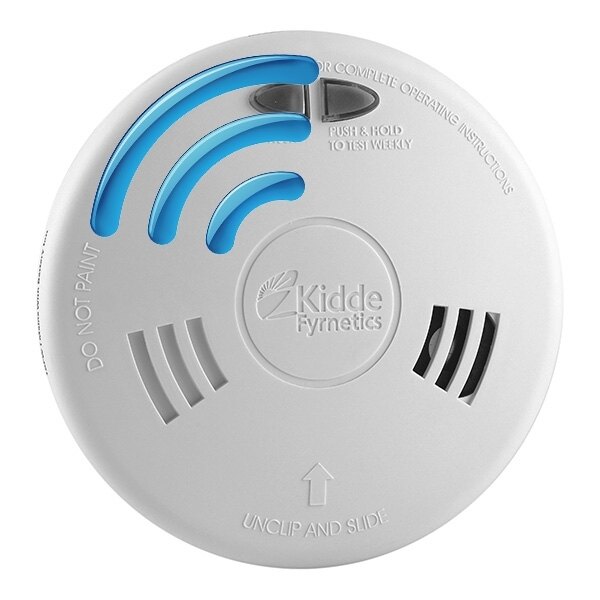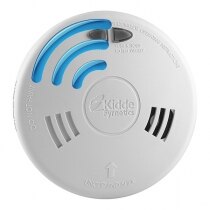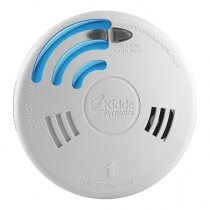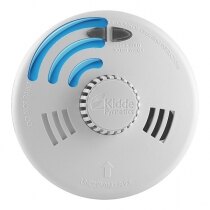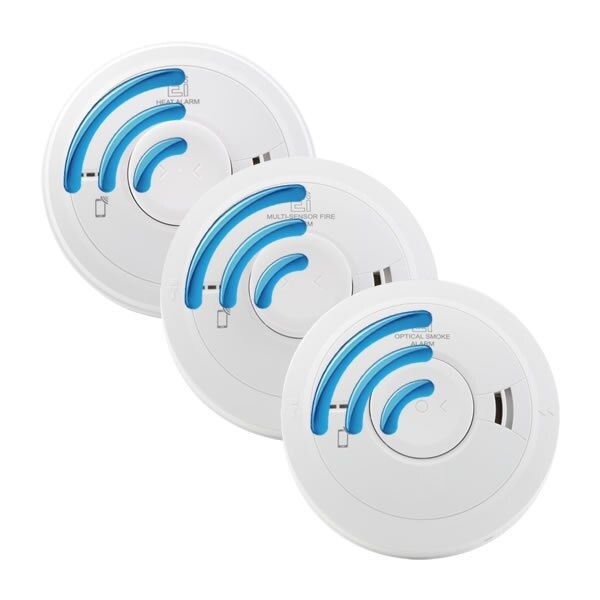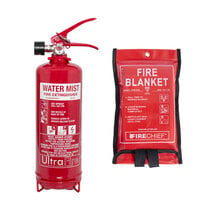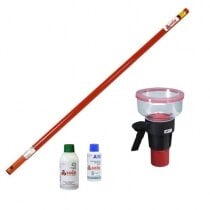-
Contact
Sales & Customer Service
0800 612 6537 support@safelincs.co.uk Live ChatDelivery Enquiries
0800 077 6149 - Resources
Fire & Safety Solutions
CALL OUR TEAM NOW 0800 612 6537
Lines open today 8am - 6pm
Quick Delivery
From £4.19 inc VAT
Live Chat - Online
Instant help & Advice
Trade Discounts
and exclusive pricing
0% Credit Available
Open an account now
5 Star Customer Feedback
Mains Radio-Interlink Smoke Alarms & Heat Alarms with Self-Charging 10 Year Back-up Battery - Kidde Slick SFLLWRF
Discontinued Product
This product has been discontinued.
alternative product
Mains Powered Smoke Alarms with Lithium Back-up Ei3000RF Series
- Available in Optical, Heat and Combined Optical and Heat
- Mains powered alarms with tamper-proof lithium back-up batteries
- Suitable for BS 5839-6: 2019 Grade D1 installations
- Supplied with an Ei3000MRF SmartLINK Module for radio-interlinking
- Hybrid (wired or wireless) interlinking with up to 12 compatible devices
- Please note: alarms are sold individually
- Also suitable for both the Welsh and Scottish 2022 legislation
£112.27 inc VAT
£93.56 ex VAT
Product Overview
Interlink
Technical Data
FAQs (5)
Kidde Slick radio-interlinked (RF) smoke and heat alarms are mains powered with lifetime self-charging lithium back-up batteries designed to last the full 10 year lifespan of the alarms and can be wired to the nearest light fitting. The units use radio technology to 'talk' to each other: when one alarm activates, all other units that are interlinked via radio-interlink begin to alarm within seconds. The RF technology negates the need for connection wire, making the installation simpler and cheaper.
- Mains Powered with sealed self-charging lithium battery – never needs replacing!
- Suitable for installations complying to BS 5839-6: 2019 Grade D1
- Kitemarked to BS EN 14604 (smoke), BS 5446-2 (heat), and CE marked
- 10 year warranty
- All alarms also act as repeaters
- Unique identification coding eliminates RF interference with other equipment
- Up to 15 units can be interlinked
- Available in 3 versions
- KE1SFLLWRF: Ionisation: for landings
- KE2SFLLWRF: Optical: for hallway, living rooms, bedrooms
- KE3SFLLWRF: Heat detector: for kitchen and garage
- Simple 'house coding'
- Frustration-free! No more beeping during the night because the battery needs changing
- Neat Slimline Design
- Easy connection to wireless remote test and hush switch
- Very easy installation
- LED display
- Test/Hush button
- Low battery warning chirp
- Please note: alarms are sold individually
- This alarm is also suitable for the updated 2022 Scottish legislation for fire alarms in homes
Please Note: These units use the radio-interlink frequency 868.499MHz. This bandwidth is restricted for safety products, therefore the chances of interference should be limited.
The table below shows all the units that can interlink with the KE1SFLLWRF, KE2SFLLWRF and KE3SFLLWRF.
Alarms from the Same Series
|
Model Number
|
Type of unit
|
Type of interlink
|
| KE1SFLLWRF | Ionisation Alarm with 10 Year Lithium Cell | Wireless interlink |
| KE2SFLLWRF | Optical Alarm with 10 Year Lithium Cell | Wireless interlink |
| KE3SFLLWRF | Heat Alarm with 10 Year Lithium Cell | Wireless interlink |
Compatible Alarms
|
Model Number
|
Type of unit
|
Type of interlink
|
| KE1SFWRF | Ionisation Alarm with Alkaline Battery | Wireless interlink |
| KE2SFWRF | Optical Alarm with Alkaline Battery | Wireless interlink |
| KE3SFWRF | Heat Alarm with Alkaline Battery | Wireless interlink |
Ancillary Products
|
Model Number
|
Type of unit
|
Type of interlink
|
| KESRFRTH | Remote Control Test and Hush Switch | Wireless interlink |
| Product Code |
KE1SFLLWRF Radio-Interlinked Ionisation Smoke Alarm: KE1SFLLWRF KE3SFLLWRF Radio-Interlinked Heat Alarm: KE3SFLLWRF KE2SFLLWRF Radio-Interlinked Optical Smoke Alarm: KE2SFLLWRF |
|---|---|
| Brand | Kidde |
| Back-Up Battery | Self-Charging Lifetime Lithium |
| Dimensions (HxDia) | Ionisation: 60x135mm Optical: 60x135mm Heat: 89x135mm |
| Operating Temperature | 0°C to +40°C |
| Relative Humidity | Up to 93% Relative Humidity (RH) |
| Sound Output | 85dB |
| Weight | 0.48kg |
| Product Datasheets |
Q. My ceiling light is on a dimmer switch. Can I still power my radio-interlinked mains smoke alarms from this lighting supply?
A.
In modern housing the lighting circuit will travel around your house with the lights being fed from it. Between the circuit and the light will be a switch (or in this case a dimmer) which will control the light. Your mains powered alarms are connected directly to the circuit and have constant power, so are not affected by switches or dimmers. In older homes that have not had the electrics updated this may not be the case so it is advisable to consult an electrician.
Q. Does this alarm conform to BS 5446 part 1 as recommended by the Fire Service?
A.
BS 5446-1:2000 was withdrawn in 2008 and replaced by BS EN 14604:2005 to conform with European standards. All of our alarms containing a smoke detector (smoke only, smoke & heat, smoke & CO) are fully compliant with BS EN 14604:2005. They also comply with any other relevant standards relating to their other detection capabilities.
Q. Can I expand an existing system of Kidde Slick mains powered smoke alarms (with existing interlink through cable) with additional Slick RF smoke alarms as shown in http://www.safelincs.co.uk/kidde-slick-wireless-smoke-alarms/?
A.
Yes, you need to add an RF base to just ONE of the existing smoke alarms. Make sure you connect the existing interconnect cable into the slot marked 'i' on the new RF base. Then you can add new RF slick smoke alarms to the system. Just make sure you go through the 'enrolment' process again to ensure all units recognise each other.
Q. What sort of smoke alarm system would I need to install for a HMO?
A.
BS 5839-6 recommends that one or two storey HMOs with an individual floor area of no more than 200sqm (not the total of both floors) should have a Grade D smoke alarm system installed. Grade D refers to mains powered smoke alarms with a back up battery power supply. The alarms can be interlinked either by wire or by radio signal and the system does not require a separate fire alarm panel. For HMOs of 3 storey or higher, a Grade A panel system would need to be installed. This can cover the whole of the building, or can be used just for the communal areas with a separate Grade D system installed for the individual dwellings. For both applications, the level of cover should be a minimum of LD3 (in all escape routes) but this may change according to the fire risk assessment.
Q. Please could you tell me how long it takes to charge up the battery on the Kidde radio interlinked bases?
A.
Hello, it takes 24 hours to fully charge the back up battery on the Kidde radio interlinked bases.
Approved Partner
Customer Reviews
4 customers have given this product an overall rating of 4 out of 5
Reviews by real customers
All of our product reviews are written by real customers that have purchased this product from us and are published without modification.Rating: 4 / 5 Stars
Reviewed by:
Install and configuration as per manual - effectiveness not tested as no fire in building yet!
Published on: 13th April 2015
Rating: 4 / 5 Stars
Reviewed by:
Published on: 23rd July 2012
Looking for more information?
If you have any questions or would like more information about this product you can ask one of our specialists.
Live Chat Available Now
Direct Telephone
01507 464181




















